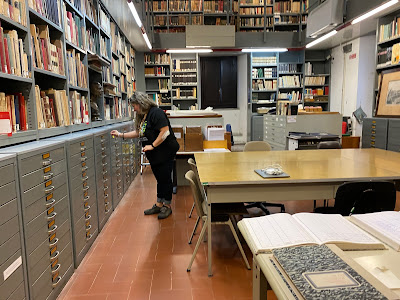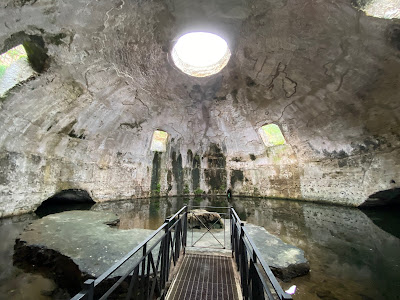My previous visit to Italy had been more than a year ago, so it was time to head back there in early November. I had several good reasons for my trip. I was going to participate in a conference on ancient identities, where I'd present a paper related to my research. In addition to this, I was going to visit a couple of archives to advance my research on Ostia and to explore two recently opened private houses in Pompeii that contained material that was of interest for my doctoral research. My trip was funded by Svenska Kulturfonden and the Finnish Institute in Rome. I'm thankful for their support.
I flew to Rome early on Monday morning on 6 November, and immediately headed to the BiASA archive at the Palazzo Venezia in the center of Rome, hoping to examine materials related to the late 19th century excavations in Ostia. I had confirmed in advance via email that the materials should be available. However, upon reaching the archive I was informed that the archive room I was looking for was only open on Tuesdays and Thursdays. I would have to come back the next day. Calculating that I would have time to return to the archive on Tuesday afternoon, I spent the rest of the day exploring the center of Rome and returned to my accommodation early to catch up on sleep.
 |
| A moment of reflection after my unsuccessful visit to the BiASA archive |
I had arranged a visit to the archives in Ostia on Tuesday morning to study materials related to my research on the theater of Ostia. This visit went as planned. I had been to Ostia a couple of times before to read excavation reports from the early 20th century (previously in my blog: Searching for the Theatre of Ostia in the Archives). This time I mainly verified some details in the reports and supplemented my notes.
 |
| My visit to the archives of Ostia was more successful. You can see me almost smiling. |
I returned from Ostia in the afternoon and hurried back to the BiASA archive. However, this time I was told that the archive room I wanted to visit was only open until two o'clock on Tuesdays and Thursdays, and it was already half-past two. The members of the staff tried to find a solution, and I was asked to wait for a moment. Soon, a person whom I understood to be the director of the archive arrived. She wanted to know what was going on and why I hadn't contacted her in advance. I tried to explain this with my poor Italian. After some discussion and animated gesturing and sighing, she reluctantly agreed to let me into the archive. Two very friendly archivists helped me find the material I was looking for, which turned out to be much more extensive than I had imagined. I examined some late 19th-century photographs and a watercolor painting of the theater of Ostia and realized it would be better to come back at a more suitable time.
 |
| At the BiASA archive in the tower of Palazzo Venezia |
 |
| With Jasmin and Maria at the Porticus Octaviae |
On Tuesday evening, I met my fellow researchers Maria and Jasmin, and we went for aperitifs and dinner. We had all come to Rome to participate in the Arachne IX conference entitled "Gender, Identities, and Social Structures in Greco-Roman Antiquity". The conference was organized by the Nordic Arachne network, founded by Finnish and Swedish researchers interested in ancient gender studies. Most participants were from Finland and Sweden, but there were researchers from many other countries including North America and Australia.
 |
| Wine reception at the Swedish Institute in Rome |
 |
| Keynote lecture by Marjatta Nielsen at the Finnish Institute in Rome |
 |
| Me presenting my paper. Photo: Iida Huitula |
After the conference on Friday, I took a train to Naples. I had planned to visit Pompeii to see two private houses that had recently been opened to the public after extensive restoration. These houses contain material relevant to my research. I was at the gates of Pompeii early on Saturday morning, rushing straight to my first destination, the so-called House of the Vettii. There I studied wall paintings and inscriptions likely related to prostitution conducted in the house. Similarly explicit paintings have been found only in a handful of Pompeian houses.
 |
| The peristyle garden of the House of the Vettii |
 |
| The backroom decorated with explicit wall paintings, perhaps a space for prostitutes to conduct their business. |
 |
| A graffito advertising the services of a woman called Eutychis, scratched on the wall of the entrance to the house. |
 |
| Priapus, the god of fertility, painted on a wall near the entrance. |
My second destination was the so-called House of the Silver Wedding, one of the largest private houses in Pompeii. It is also one of the few houses where numerous graffiti are still visible on the walls. Many of these are sexual insults and therefore important for my research. I knew the location of some inscriptions, but I had to search for others. A few enthusiastic custodians of the house helped me in my search. We found at least two phallic drawings.
 |
| The atrium of the House of the Silver Wedding |
 | ||
| This room that opens to the peristyle garden has about a dozen graffiti still visible on the walls.
|
It was very enlightening to see these scribblings with my own eyes in their original environment. Many of them were written on the walls of a room located on one side of the large peristyle garden (see the photos above). This room was perhaps used as a dining room, which makes you wonder who wrote them in that particular place and why. As I explored the room, many passers-by stopped to stare curiously at me while I worked. I had conversations with some of them about the wall inscriptions, including a local archaeologist and an American couple.
 |
| The Forum Baths were open to the public again. The photo is from the tepidarium, one of the warm rooms. |
Many tourists visit Pompeii with guides whose expertise is not always impressive. During this visit, I heard one guide telling their clients that probably at least 10,000 people died when Pompeii was destroyed. Researchers usually estimate around 2,000 victims. Another guide claimed that the great brothel of Pompeii had thousands of graffiti on its walls. She may have exaggerated on purpose. Only some 120 inscriptions have been documented in the brothel. I also had to correct the archaeologist I met in the House of the Silver Wedding, who claimed that at least 90% of the inscriptions were obscene. Only a few hundred of the over 10,000 graffiti documented in Pompeii contain indecent language. Reality is sometimes less sensational than we would like to imagine.
 |
| For the first time I got to climb on top of one of the towers of the city wall. The view is to the south towards the forum. |
Before my trip I had applied for permission to access the storerooms of the Archaeological Museum of Naples to study wall inscriptions stored there. However, the museum never responded to my request, so I had to come up with other plans for Sunday. I took a bus to the western end of the Bay of Naples to visit the archaeological site of Baiae, which was a popular vacation spot for the Roman elite. There I saw the ruins of imperial-era baths, among which is the oldest surviving dome built by the Romans. The acoustics in this round room, later filled with water, were incredible. I also visited the archaeological museum located in a castle built on a hill by the bay in the late 15th century.
 |
| The archaeological area of Baiae consisting of multiple baths built on the slopes of a hill |
 |
| The domed space probably originally served as a frigidarium, a cold bath. The room has later become partly submerged due to seismic activity. |
On Monday morning I returned to Rome by train, where I spent a few hours wandering around the city. In the evening I flew back to Finland satisfied with a successful conference and research trip.



No comments:
Post a Comment